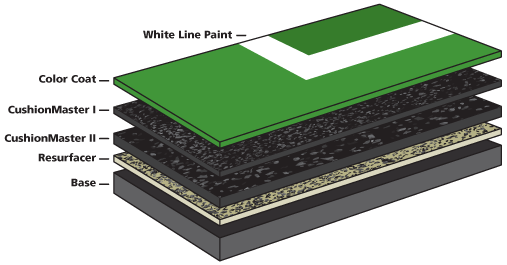Pickleball Court Construction-- Expert Installation for Your Desire Court
Pickleball Court Construction-- Expert Installation for Your Desire Court
Blog Article
Lasting Practices in Pickleball Court Building And Construction You Must Know
As the appeal of pickleball remains to climb, so also does the demand for lasting methods in court construction. This strategy not only addresses ecological worries but also improves the long life and functionality of the courts. From selecting environment-friendly products to applying efficient drainage and energy-saving lights remedies, there are many methods to think about. Yet, the effect of these methods extends much beyond the court itself. Understanding how each element adds to a much more lasting future invites additionally expedition into the elaborate balance in between recreational development and ecological stewardship.
Picking Eco-Friendly Materials
Picking environmentally friendly materials is a crucial step in the building of lasting pickleball courts. The selection of lasting products not only decreases environmental impact but likewise improves the durability and efficiency of the court. Key products include recycled rubber for the surface, which supplies exceptional durability and shock absorption while diverting waste from garbage dumps.
Furthermore, making use of in your area sourced products minimizes transport emissions and supports regional economic situations. Pickleball court construction. For instance, utilizing native hardwoods for fencing and seats can supply a lasting visual while making certain strength versus the elements.
Incorporating absorptive products for court structures can even more contribute to sustainability by permitting natural water drainage and lowering overflow. These selections not just protect regional environments yet likewise promote much healthier play environments.
Efficient Drainage Solutions
While the option of environment-friendly products is essential, implementing effective drainage options is equally critical for maintaining sustainable pickleball courts. Correct water drainage not just protects the court surface from water damages however additionally reduces disintegration and overflow, advertising ecological integrity.
Efficient water drainage systems can include permeable paving, which permits water to infiltrate the ground rather than merging on the surface area. This minimizes the possibility of standing water, which can lead to mold and mildew and various other maintenance problems. Additionally, incorporating strategically positioned water drainage networks and swales can direct excess water far from the court location, making sure a dry having fun surface area and protecting against dirt disintegration.
Making use of native vegetation in the landscape design around the courts can additionally enhance drain by absorbing excess water and lowering drainage. These plants call for much less irrigation and advertise biodiversity, straightening with lasting techniques.
Furthermore, it is vital to routinely keep the drainage system to ensure its long-term performance. This consists of clearing debris and tracking for clogs. By focusing on reliable drain remedies, pickleball court fitters can considerably add to the sustainability and longevity of the facility, ultimately benefiting both players and the atmosphere.
Energy-Efficient Lights Options
As the need for pickleball remains to grow, integrating energy-efficient lighting choices right into court style has actually become increasingly essential for sustainability. Traditional lights systems often consume excessive energy, adding to higher operational costs and ecological influence. Taking on modern, energy-efficient innovations is important for both new buildings and renovations.
LED (Light Emitting Diode) lighting sticks out as a premier choice as a result of its durability and power cost savings (Pickleball court construction). Contrasted to standard illumination, LEDs make use of roughly 75% less energy and can last as much as 25 times longer, considerably decreasing upkeep expenses. The directional nature of LED illumination reduces light air pollution, making sure that lighting is focused on the court rather than bordering areas.

Lasting Surface Alternatives
Discovering sustainable surface area alternatives for pickleball courts has gotten traction among contractors and players alike. The focus on eco-friendly materials not just aligns with the growing environmental understanding however additionally boosts the efficiency and durability of the courts.
This product offers exceptional shock absorption, decreasing the danger of injuries for players while promoting sustainability. These floor tiles are very easy to mount and visit replace, and their convenience permits for numerous court configurations.
Natural yard courts are likewise arising as a sustainable option, advertising biodiversity and minimizing the heat island result. However, they need regular maintenance and water, which may not line up with all sustainability objectives.

Water Preservation Strategies
Another reliable method involves the setup of rain harvesting systems. These systems accumulate and keep rain for use in keeping court surface areas and landscaping. This approach not just saves potable water but also reduces reliance on metropolitan sources.
Moreover, utilizing drought-resistant landscape design around the courts is necessary. Indigenous plants require less water and are much better adjusted to local environment problems, thus reducing total water consumption. In addition, utilizing effective watering systems, such as drip watering, ensures that water is provided directly to plant roots, lessening dissipation and waste.
Conclusion
Integrating lasting techniques in pickleball court building and construction substantially adds to environmental conservation and resource efficiency. Utilizing green products, executing reliable water drainage remedies, and embracing energy-efficient illumination choices can greatly lower eco-friendly impact. Exploring lasting surface area alternatives and utilizing water conservation strategies improve the total sustainability of these recreational centers. By prioritizing these techniques, the building and construction of pickleball courts can line up with broader ecological my response goals while promoting longevity and performance within neighborhoods.
As the popularity of pickleball continues to increase, so too does the need for sustainable practices in court building and construction.Picking environmentally friendly materials is an essential step in the building and construction of lasting pickleball courts. By focusing on energy-efficient lights choices, pickleball court producers can contribute to a much more sustainable future while satisfying the requirements of stakeholders and players alike.Including sustainable surface options not only boosts the efficiency of pickleball courts but also leads the method for implementing effective water conservation techniques.Integrating sustainable practices in pickleball court building and construction dramatically contributes to environmental preservation and resource efficiency.
Report this page